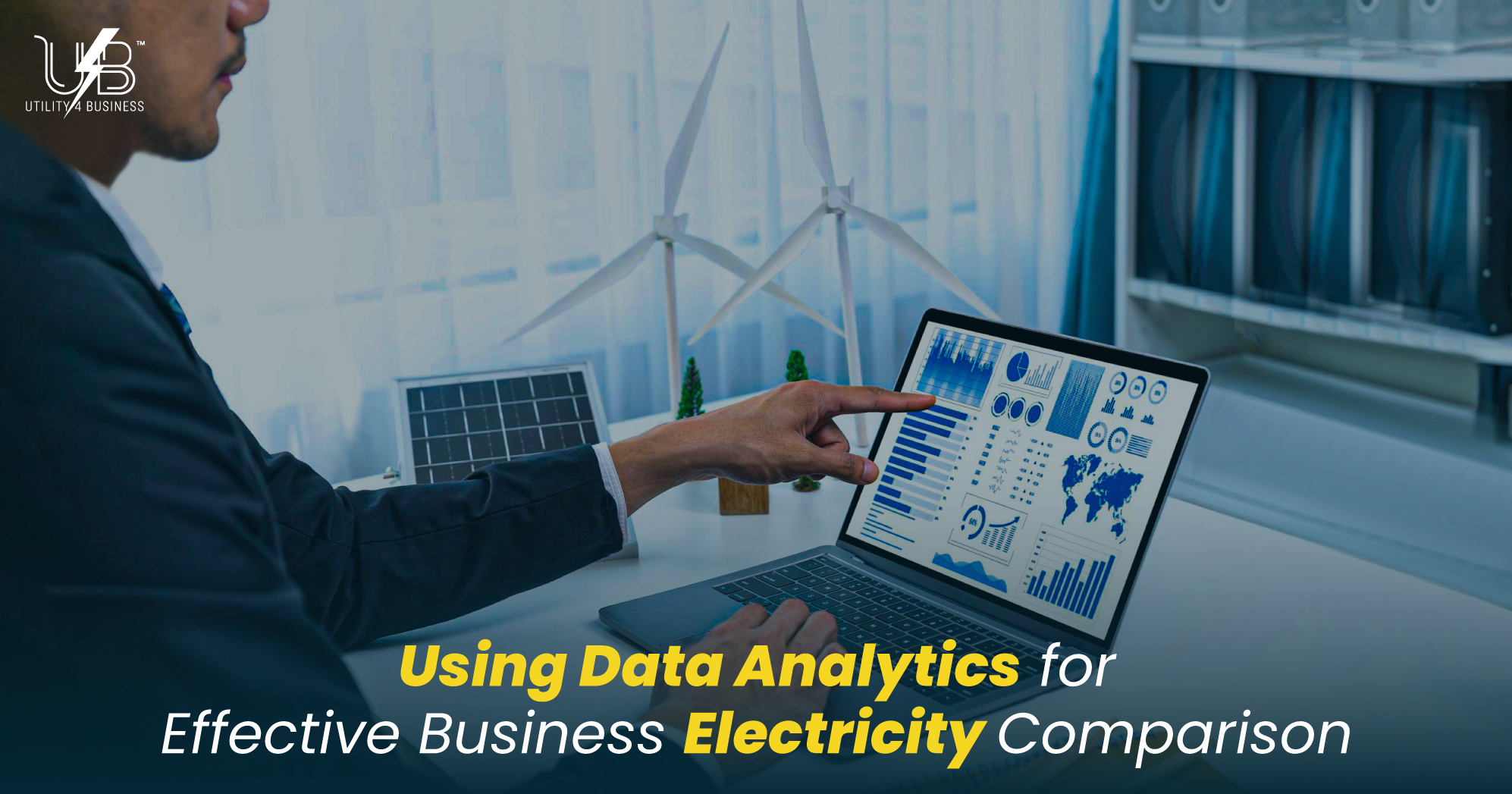Using Data Analytics for Effective Business Electricity Comparison
Cut Business Energy Costs with Data

Energy costs keep changing, and bills can increase for no reason at all. On the plus side, with data, you can now choose the correct tariff with certainty. This guide explains how data analytics turns a routine business electricity comparison into a clear, numbers-driven decision. It walks through the data needed, the analysis that matters, and the steps that help a UK business lock in better value. Examples refer to Utility4Business to keep things practical and focused.
Why accurate comparison matters
When a project chooses the right electricity plan, it affects their margins, cashflow, and long-term plans. A small price gap per kWh adds up across months and sites. Good choices also support net-zero plans because cost and carbon often move together when usage is wasteful. Clear comparison helps finance teams set accurate budgets and gives operations teams a target to beat. It also brings transparency to extras like standing charges, demand charges, and time-of-use rates. With clean data and the right checks, a comparison business electricity exercise becomes a smart business move, not a guess.
Where does the data come from
The strongest comparisons start with the business’s own usage. Recent bills show spend and meter reads. Half-hourly or smart meter data shows the true load shape, including morning ramps, lunch dips, and late peaks. Building systems and IoT sensors add context like temperature, occupancy, or production schedules. External data matters as well. Tariff sheets, contract terms, and market signals show what suppliers offer today and over the next period. When these sources align, business electricity price comparison becomes accurate and fair.
The analytics that make a difference
Descriptive analytics shows what happened. It shows peak times, weekend baselines, and aberrant spikes. Predictive analytics uses the past and things we know (trends, seasonality, known events) to forecast what may occur in the next month or next quarter. Prescriptive analytics provides decision-making based on that knowledge. It tests tariffs, contract lengths, and time-of-use options against the expected load profile. It also flags risk, like exposure to peak prices or penalties. Together, these methods deliver a stronger compare commercial electricity decision than a simple rate check ever could.
Key Steps in Setting Up a Comparison Framework
Collect and validate data
Start with the last twelve months of bills and, if available, half-hourly meter data. Check that the meter serials match and that the readings follow a clear order. Confirm that VAT and Climate Change Levy are handled as expected. Align business events to usage, such as a new shift pattern or HVAC changes. Fill gaps with careful estimates based on adjacent periods. Validation takes time, but it saves more time later because every comparison rests on this base. Clean inputs produce clean results.
Normalise and benchmark
Convert all usage into kWh and demand into kW. Map time stamps to local time and to working hours. Separate controllable load from base load to see where savings may sit. Normalise for weather if the site is heating or cooling heavy. Benchmark each site against the portfolio average to find outliers. This makes business electricity comparison across multiple locations fair and consistent. Normalisation also helps when testing new tariffs because the model then reflects the real shape of use, not a single bill snapshot.
Profile the load
Create a daily and weekly usage profile. Identify the top ten peak half hours and the top demand days. Note the spread between daytime and evening use. If a site runs a large motor or oven cycle, mark those times. Peaks matter because many tariffs price them differently. A site with sharp peaks may pay more under a tariff with high demand charges. A flat site may do well with a simple unit rate. With a clear profile, comparing business electricity becomes a match between tariff design and actual behaviour.
Build the cost model
Translate the profile into a cost forecast for each tariff under review. Include unit rates, standing charges, demand charges, capacity costs, triad-style signals where relevant, and time-of-use bands. Apply contract length options and review any green energy premiums. Test a base case using last year’s usage and a forward case using expected changes, such as a new line or extended hours. Run sensitivity checks for price movement and weather. This shows not only the likely winner today but also which option holds up if conditions shift.
Find anomalies and risk
Scan the data for sudden spikes, meter rollovers, or repeated estimates. If a site shows lights-on levels overnight, investigate controls or timers. Clear outliers can distort a business electricity price comparison result, so fix them before finalising. Then assess risk. A tariff that looks cheap under perfect behaviour may punish a site when a shift overruns. The best choice balances headline price with operational tolerance.
Turn analysis into action
Insights only help when teams can use them. Present the findings in plain language. Show the annual cost by tariff option. Explain why the winner suits the load shape. Share the financial range under realistic changes, not just a single point. Set a review date before the contract ends so the business electricity comparison cycle continues. When a new kit or schedules change the profile, refresh the model. Make the process part of routine energy and finance reviews.
Benefits and common hurdles
A rigorous business electricity comparison process delivers clear savings, steadier budgets, and stronger ESG reporting. It also highlights quick wins like fixing night baseload or moving flexible loads out of peak windows. The usual hurdles are missing data, messy meter histories, and confusion over charges. These fall away with a simple rule: clean data first, then model, then decide. When teams follow the same steps each time, the process becomes fast and reliable.
Best practices that keep results strong
Use at least twelve months of usage to cover seasons. Keep a single source of truth for meter and tariff data. Document every assumption. Review actual spend against the forecast each quarter and note the causes of any gap. Fold operational changes into the next run. Treat comparing commercial electricity as an ongoing rhythm, not a one-off task. Over time, the model becomes more accurate, and negotiations improve because the business can speak in clear kWh, kW, and time-band terms.
Future trends to watch
More UK meters now provide rich interval data, which makes profiles sharper. Real-time analytics is moving from dashboards to alerts that flag unusual use within hours, not weeks. AI-driven forecasting reduces manual work and helps plan around weather and events. Carbon tracking is also merging with cost models so that the business electricity comparison shows pounds and emissions side by side. These trends reward teams that already collect clean data and review contracts with a model-based approach.
Conclusion
Data analytics changes how UK businesses buy electricity. With clean inputs, a strong profile, and a transparent cost model, comparing commercial electricity becomes fast and reliable. The best choice balances price with the way each site runs day to day. Utility4Business turns that process into a repeatable playbook, from the first data pull to the signed contract. The result is better value now and fewer surprises later, backed by a method that improves with every cycle.
Find This Article Helpful? Share It Now!
At Utility4Business, we offer top-notch customer support and business utility solutions for businesses across the UK. Consider sharing this article and helping others discover how our expertise can add value to their business success.

Read Our Latest Posts
Explore our latest blog posts and learn how Utility4Business can support your business growth with tailored utility solutions and services. Stay ahead of the curve with the latest information from industry experts and take advantage of our user-friendly comparison services to find the best business deals.


Get Connected
At Utility4Business, our team of experts can help you figure out the highest-value business utility deals that will help your business grow over time.


